The Biopotential Sensor Market is estimated to be valued at USD 1.3 billion in 2025 and is projected to reach USD 3.1 billion by 2035, registering a compound annual growth rate (CAGR) of 9.0% over the forecast period.
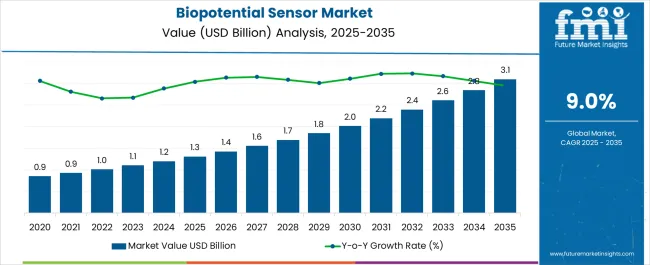
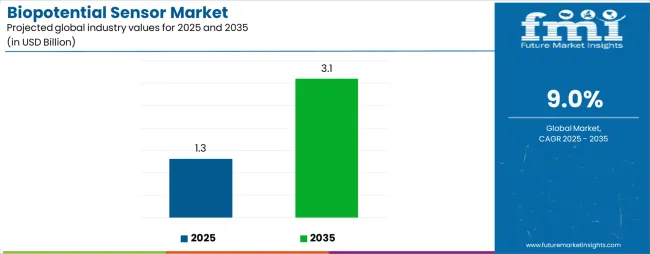
| Metric | Value |
|---|---|
| Biopotential Sensor Market Estimated Value in (2025 E) | USD 1.3 billion |
| Biopotential Sensor Market Forecast Value in (2035 F) | USD 3.1 billion |
| Forecast CAGR (2025 to 2035) | 9.0% |
The Biopotential Sensor market is experiencing rapid expansion as demand for real time physiological monitoring grows across both consumer and healthcare applications. In 2025 the market outlook is being shaped by the integration of sensors with wearable devices, fitness platforms, and medical monitoring systems that require non invasive and continuous measurement of electrical signals generated by the body.
Growth has been enabled by advancements in miniaturization, low power electronics, and wireless connectivity that make biopotential sensors more adaptable for daily use. Rising consumer awareness of health management and proactive wellness tracking has contributed to higher adoption rates, while ongoing development of connected healthcare ecosystems has created opportunities for innovation.
The ability of these sensors to generate accurate, high frequency data streams supports applications ranging from athletic performance optimization to patient monitoring in telehealth environments As investment in personalized medicine and preventive healthcare intensifies, biopotential sensors are expected to remain integral to the broader wearable technology landscape with robust growth potential in both developed and emerging economies.
The biopotential sensor market is segmented by application, end use, and geographic regions. By application, biopotential sensor market is divided into Fitness Applications and Medical Applications. In terms of end use, biopotential sensor market is classified into Personal Fitness Tracking, Medical, Electrocardiogram Measurements, R-R Tracking, and Other Medical End Uses. Regionally, the biopotential sensor industry is classified into North America, Latin America, Western Europe, Eastern Europe, Balkan & Baltic Countries, Russia & Belarus, Central Asia, East Asia, South Asia & Pacific, and the Middle East & Africa.
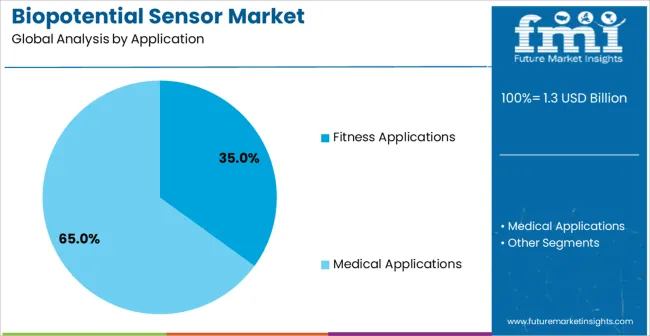
The Fitness Applications segment is projected to account for 35.00% of the overall Biopotential Sensor market revenue in 2025, positioning it as the leading application area. This dominance is being driven by the widespread incorporation of biopotential sensors into smart wearables such as fitness bands, chest straps, and sports performance monitors that provide continuous tracking of vital signs.
Growth has been supported by consumer preference for self monitoring solutions that deliver actionable insights on physical activity, cardiovascular health, and stress levels. The rising global adoption of fitness and wellness lifestyles has created steady demand for advanced sensor technologies that ensure accuracy and long battery life.
Manufacturers have also emphasized software integration with mobile applications and cloud based analytics platforms, further strengthening the appeal of these devices for both casual users and professional athletes The ability of biopotential sensors to translate complex physiological data into easy to interpret metrics has enhanced user engagement, driving repeat purchases and higher device penetration.
The Personal Fitness Tracking segment is expected to capture 30.00% of the Biopotential Sensor market revenue in 2025, making it the leading end use segment. This position has been reinforced by strong consumer demand for wearable devices that enable personalized health monitoring outside of clinical settings.
Adoption has been encouraged by the convenience of real time feedback on parameters such as heart rate variability, muscle activity, and sleep quality, which allow individuals to optimize workouts and manage wellness goals. Increasing consumer interest in preventive healthcare has been central to segment growth, as biopotential sensors provide early insights into potential health risks through continuous monitoring.
The integration of these sensors into multifunctional consumer electronics such as smartwatches has also broadened accessibility and reduced costs, accelerating uptake among a wide demographic With the global trend of digital health adoption and rising investment in connected ecosystems, personal fitness tracking is expected to remain the dominant end use, supported by advancements in sensor accuracy, miniaturization, and battery efficiency.
The human nervous system utilizes the ebbing and flow of ions in order to communicate. The transportation of ions within nerve fibers can be measured on the skin surface using an electro-chemical sensor, commonly referred to as a surface recording electrode or a biopotential sensor.
The primary purpose of the surface recording electrode is to act as a transducer between the electron flow in the copper wire that is integrated in the system and the ionic transport within and along the nerve fiber. Biopotential sensors are incorporated in the process to detect the small electrical signal emitted within the human body.
These electrical signals detected by biopotential sensors are conditioned and forwarded to a microprocessor that calculates and stores the data. The microprocessor then commands the health monitoring device to display the data gathered.
Such devices with integrated biopotential sensors are procured by users, fitness trainers and medical personnel in order to monitor fitness trend or determine the heath condition of a patient under observation. Some cardiac parameters that can be monitored using biopotential sensors include, R-R intervals and Electrocardiogram (ECG).
Biopotential sensors produce ECG waveforms, bioimpedance measurement, and pacemaker edge and heart rate detection, which enable the medical authorities to calculate the patient’s respiration.
Manufacturers offer bioimpedance (BioZ) and biopotential AFE (Analog Front-end) solutions for cardiac health monitoring applications. These biopotential sensors facilitate ultra-low power operation, clinical-grade accuracy and enable long battery life when used for fitness applications.
Manufacturers are also offering biopotential sensors in smaller wafer-level packages in order to support wearable medical applications, such as chest straps and wrist-worn fitness devices.
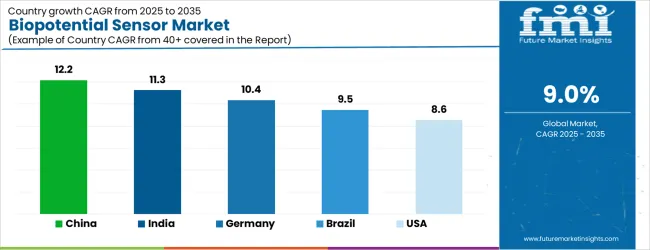
| Country | CAGR |
|---|---|
| China | 12.2% |
| India | 11.3% |
| Germany | 10.4% |
| Brazil | 9.5% |
| USA | 8.6% |
| UK | 7.7% |
| Japan | 6.8% |
The Biopotential Sensor Market is expected to register a CAGR of 9.0% during the forecast period, exhibiting varied country level momentum. China leads with the highest CAGR of 12.2%, followed by India at 11.3%. Developed markets such as Germany, France, and the UK continue to expand steadily, while the USA is likely to grow at consistent rates. Japan posts the lowest CAGR at 6.8%, yet still underscores a broadly positive trajectory for the global Biopotential Sensor Market.
In 2024, Germany held a dominant revenue in the Western Europe market and is expected to grow with a CAGR of 10.4%. The USA Biopotential Sensor Market is estimated to be valued at USD 454.9 million in 2025 and is anticipated to reach a valuation of USD 454.9 million by 2035. Sales are projected to rise at a CAGR of 0.0% over the forecast period between 2025 and 2035. While Japan and South Korea markets are estimated to be valued at USD 62.3 million and USD 43.2 million respectively in 2025.
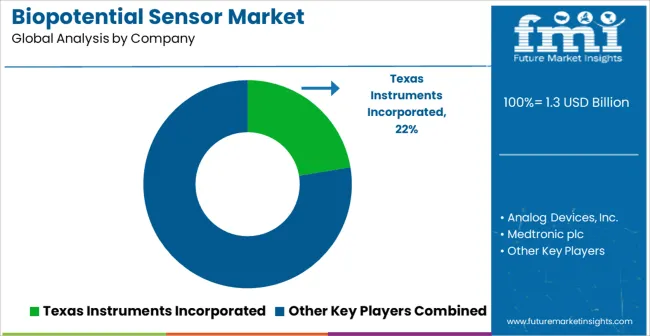
| Item | Value |
|---|---|
| Quantitative Units | USD 1.3 Billion |
| Application | Fitness Applications and Medical Applications |
| End Use | Personal Fitness Tracking, Medical, Electrocardiogram Measurements, R-R Tracking, and Other Medical End Uses |
| Regions Covered | North America, Europe, Asia-Pacific, Latin America, Middle East & Africa |
| Country Covered | United States, Canada, Germany, France, United Kingdom, China, Japan, India, Brazil, South Africa |
| Key Companies Profiled | Texas Instruments Incorporated, Analog Devices, Inc., Medtronic plc, NXP Semiconductors N.V., Maxim Integrated, Siemens Healthineers AG, Philips Healthcare, and GE Healthcare |
The global biopotential sensor market is estimated to be valued at USD 1.3 billion in 2025.
The market size for the biopotential sensor market is projected to reach USD 3.1 billion by 2035.
The biopotential sensor market is expected to grow at a 9.0% CAGR between 2025 and 2035.
The key product types in biopotential sensor market are fitness applications, _chest straps, _wrist-worn devices, medical applications, _arrhythmia detection patches, _chest straps, _remote patient monitoring systems, _ecg monitors and _other wearable patient monitors.
In terms of end use, personal fitness tracking segment to command 0.3% share in the biopotential sensor market in 2025.
Explore Similar Insights

Thank you!
You will receive an email from our Business Development Manager. Please be sure to check your SPAM/JUNK folder too.
Chat With
MaRIA